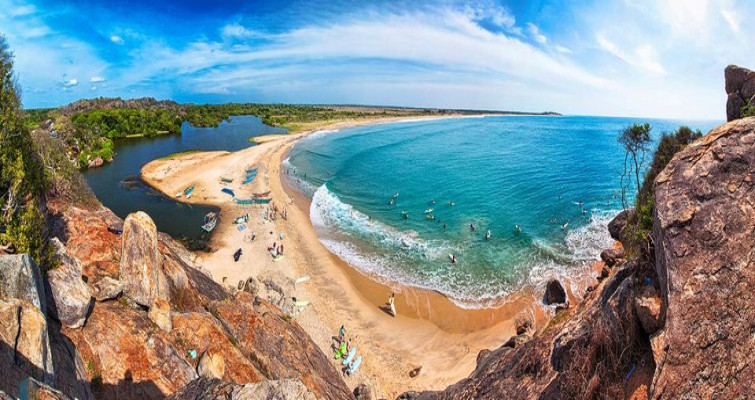
22
Oct
By : harshani @ 22 Oct 2023 1.1K
Sri Lanka, which is full of attractive geographical locations and scenic views, will be a top destination in 2023. According to the well-known Global Travel Journals, Sri Lanka is among the top countries in the world to travel in 2023. In fact, there are many beautiful places to visit. The beautiful beaches of the coast of Sri Lanka, The amazing countryside in the mountains, with activities and adventures, all travelers who come to this beautiful island will be delighted
Let's figure out the most famous place you can visit visiting South East of Sri Lanka and some of the tourist attractions around it.
ARUGAM BAY
Arugam Bay is a dry regional bay located on the southeastern coast of sri laka.It is located in the east of Colombo. 320 meters away. It is a popular tourist destination for foreign tourists. Arugam Bay is best known as Sri Lanka's premier surfing destination.
Top Attractions Around Arugam Bay.
01.RAJAGALA VIHARAYA

The name "Rassagala" sparks curiosity about its origin. It is speculated that the term might have evolved from the Raksha tribe, who are believed to have inhabited the area. These people, similar to humans, revered the Rakshas, and over time, the term "Raksha" could have transformed into "Rassa." This intriguing etymology adds to the mystique of Rajagala's history.It's Located in Sri Lanka's Ampara district within the Eastern Province, Rajagala stands as a rugged, densely forested mountain. Rising 1,038 feet above sea level, it remains a secluded haven on this sparsely populated island. Encompassing a sprawling 300 acres, the archaeological site holds secrets waiting to be unveiled. While Rajagala's history is still unfolding, it is believed that monks inhabited the area during the 10th to 3rd centuries BC. Stone inscriptions known as "Shila Lipi" from this era have been discovered at the site, providing glimpses into the past. The northern summit of the mountain harbours extensive ruins, partially concealed by the thick jungle, hinting at the heritage's richness.
Arahat Mihindu Thera, the bringer of Buddhism to Sri Lanka, is said to have blessed Rajagala Viharaya. Legends suggest he may have been laid to rest on this hallowed ground. A nearby stone inscription lends weight to this belief, although further exploration is needed to confirm its veracity.
Rajagala unveils a treasure trove of archaeological wonders that provide insight into Sri Lanka's history. Discoveries include dagobas, aramas (monastic complexes), ponds, dwelling places for Buddha statues, and intricately carved sandakadapahanas (moonstones). Some drawings, thought to be the work of indigenous people known as adivasies, adorn the stones, possibly dating back an astounding 35,000 years.
The optimal time to visit Rajagala is during the dry seasons, typically from May to September and December to February. These months offer the most favourable weather conditions for exploring and appreciating the site's historical and natural wonders. The dry seasons ensure minimal rainfall, which allows visitors to enjoy the outdoor experience without the hindrance of wet weather. Additionally, the clear skies during these months provide excellent visibility, enhancing the overall experience of exploring Rajagala's rich heritage and captivating landscapes. Whether you're a history enthusiast or a nature lover, planning your visit during these dry months will ensure a memorable and enjoyable time at Rajagala.
02.KUDUMBIGALA MONASTERY COMPLEX

Kudumbigala Monastery Complex is a nature reserve located about 22 km from the Yala Kumana National Forest in the eastern province and 22 km from Potuvil Ampara on a scenic rock in the center There was. This is a place where monks meditate. It is a place to visit once in a lifetime.This gem is essential for Sri Lanka and Mahatana was able to touch around 12,000 people. The Chaitya Pabbattha Vihara, which is considered to have been sacrificed to the Maha Sangharat during the reign of King Kavantisa, is held in the sanctuary of Kudumbigala Tapoa.It was later reformed by nandimithra senpathiya, who contributed to the country's alliance with king dutugemunu.The nearest town to reach Kudumbigala Monastery is Arugam Bay, which takes approximately 45 minutes.
Once you arrive, there is a lot to do in this beautiful and historic place. You can observe Brahmi inscriptions, look at the only cylindrical temple in Sri Lanka, and explore the more than 200 that make up the monastery complex.The walls of the caves are covered with mud and have a series of murals and paintings, giving the opportunity to see the beauty of spirituality and a part of the religious culture of the country. Entrance to the monastery complex is free, but it is important to note that there is no shade in the area, so it is best to avoid arriving at the hottest time of the day.
If you are interested in wildlife, Drinking Road offers a great opportunity to see elephants, crocodiles, monkeys and large birds. There are many roads, caves and rocks to explore and climbing to the top of the mountain will reward you with a spectacular view of the surrounding coastline and the lush green countryside. Kudumbigala Monastery is a special place due to its unique cylindrical architecture and is a must-visit place for anyone wishing to explore Sri Lanka's religious and cultural heritage.
03.DEEGHAWAPI MAHA THUPAYA

Deeghavapi Statue is located in the eastern province of Sri Lanka and is considered one of the thousand sacred places where Buddha works. It is believed that at the time of the work of the Buddha the Third Sri Lanka, he worked at this place and meditated with 500 guards.Thanks to its rich history, it has undergone several reforms and reforms over the centuries. On his third pilgrimage to Sri Lanka, Buddha worked in the forest at the invitation of Naga tribesman Mani Akkika, who was the ruler of the Kelaniya area. After the Buddha worked in the forest, they went to Deeghavapi with 500 craftsmen and worked there. This visit is important as Deeghavapi is the sixth place in the Solosmastan in Sri Lanka.
04.ARUGAM BAY BEACH

Arugam Bay is truly a paradise on earth, offering the best for a classic tropical vacation. With ideal conditions for surfing, ancient white sandy beaches, stunning crimson sunsets and various beachfront guest houses and hotels, Arugam Bay is the best destination for those looking for an unforgettable vacation It is the Nativity. Arugam Bay, located about 342 km east of Colombo, can be reached within 7 hours by private and public transport services such as buses.Arugam Bay is particularly attractive for its ancient coastline. The white sandy beach invites visitors to have fun in the dull afternoons, listening to the calm sound of the ocean and gently swaying on a beach. However, Arugam Bay is not only defined by its beautiful coastline; it has gained a worldwide reputation as a premier surfing spot and a hidden paradise.
Arugam Bay is qualitatively designed, attracting waves from all corners of the world. In addition, surf lovers can explore other popular places such as Popotle Point, Whiskey Point, Elephant Rock and Crocodile Rock. Arugam Bay stretches along a long sandy beach punctuated by charming fishing villages. As the tourism business in Arugam Bay has flourished, the area now has a plethora of accommodation options to suit different budgets and preferences. From luxury resorts to budget-friendly guesthouses, guests can find a place to stay that suits their needs while enjoying the area's natural wonders.Tourists can start fishing trips according to the cluster of fishing villages surrounding Arugam Bay, immerse themselves in local fishing methods and gain an insight into the vibrant coastal culture. In addition, the friendly locals and the charming beauty of Arugam Bay create a welcoming and relaxing atmosphere, appealing to adventurous divers and those looking for a calm and sunny beach.
June to August is the best time to visit Arugam Bay as the weather and wave conditions are most favorable. Arugam Bay is famous for elephant watching, especially in the evening. Stay alert as you explore the coastal area.Arugam Bay has developed luxury resorts with budget-friendly accommodation, ensuring a range of choices for visitors.
05.PEACE PAGODA VIHARAYA

Peace Chaitya Temple has an impact on peace and Buddhism.The local and foreign tourists who have dedicated themselves to relax and free their minds are grateful. Ampara Peace Center was constructed on February 27, 1988. This thanks has been made under the owners of Nichidatsu Fuji, founder of the Nipponsan Myohoji sect.The owners of Nichiatsu Fu were inspired by a meeting with Mahatma Gandhi in 1931. So he decided to voluntarily promote nonviolence. The owners of Nichiatsu Fu began building these statues in 1947, and he traveled around the world and showed communities about peace and harmony. Somehow his work has been successful.
The statues, first built in the cities of Hiroshima and Nagasaki, Japan, symbolized peace, and during World War II there was great destruction due to atomic explosions. By the end of 2000, he had built more than 80 columns in size. There are 4 temples located in different destinations in Sri Lanka. Although they were built in Ampara, Bandarawela, Galle and Walapane, it is a concept of friendship between Sri Lanka and Japan.
06.KUMANA NATIONAL FOREST

Kumana national forest is famous for its avifauna, especially its large migratory raptors and paddlebirds. The park is located 391 km southeast of Colombo on the southeast coast of Sri Lanka. Which ones are located next to the National Forest? Which predecessor was called Eastern National Forest, but changed to its current name on September 5, 2006.Kumbukkan forms the southern border of the National Forest. About 20 ponds and lakes hold incredible bird life in the National Forest.
The pond is shallow and the depth is limited to more than 2 meters. which bird sanctuary,published in 1938,Is held in which national forest.Kumana is one of the few bird nests and breeding sites in sri lanka.Two hundred and fifty-five bird species are considered in the National Forest. In April-July, thousands of birds migrate to which wetland area every year. What unique species such as Black-necked Stork, Lesser Adjutant, Eurasian Spoonbill and GreatThick-knee are the breed inhabitants of which wolves.
07.LAHUGALA KITHULANA NATIONAL FOREST

Lahugala National Forest is one of the smallest national forests in Sri Lanka. Regardless of the size of the territory, this forest is a very important habitat for elephants in Sri Lanka and birds native to Sri Lanka. The forest includes the Lahugala, Kitulana and Sengamuwa reservoirs, which are eventually drained into the Oya Oya River. Formerly it was assigned as a wildlife sanctuary on July 1, 1966. Later, on October 31, 1980, the protected zone was upgraded as the Forest. Lahugala Christulana is from Colombo. 318 meters are located in the east. This national forest is traditionally used by elephants as a feeding area. Furthermore, many wetland birds are found in Lahugala.
In addition to sri lankan Elephant ,Native tok Macaw, ,Tufted grey langer,Sloth bear,Indian munjack,Golden Jackal,Fishing Cat,Srilankan Leopard,Wild Boar.The park is home to many species of mammals, such as tigers. Axis Deer, Rusty-spotted cat, Sri Lankan Sambar Deer, Indian Pangolin and Indian Hare. In addition, the park is a sanctuary for bird watchers. Lahugala is home to a wide range of wetland birds, including the Great White Pelican, Purple Heron, Painted Stoke, Lesser Partner, Anas spp., White-bellied Sea Eagle, Grey-headed Fish Eagle, Common Kingfisher, Stork-billed Kingfisher, and White-thronated Kingfisher. There have also been reports of spot-billed Pelicans, Asian Openbill and Wooly-necked Stork going into wet ground.
The last recorded sighting of the Knob-billed Duck, currently considered extinct from Sri Lanka, took place here. Red-faced Malkoha and Sri Lanka Spur Fowl are birds native to the park.The park recently opened its doors to visitors, and instead of vehicles, visitors can observe the scenic spots designated by the park. During the monsoon season in the northeast from November to December, animals are scattered from the rain and the park takes on a bodily green hue. A trip to Lahugala Christulana National Forest is sure to fascinate you with the animals of Sri Lanka.
08.MUHUDU MAHA VIHARAYA

Muhudu Maha Viharaya is located in Potuvil, about 300 km east of Colombo. Visitors can reach the temple by road using public or private vehicles. However, it is recommended to hire a local guide for trip planning and a more enriching experience.
09.BUDDHANGALA ASAPUWA

Budhangala is from the city of Ampara. It is widely located inside the forest at a distance of 7 m. The location where the monastery remains of the historic monastery is 1280 acres and five rock faces. These inhabitants belonged to Kri. BC. It was to the Digamadulla kingdom that Prince Deighyu began exploiting it in the 4th century. The origins of this monastery are unclaimed, and the owners of the priestly altars suggest that the history of their monastery is as old as the Kingdom of Digamadulla.A dense forest strewn with animals that have been exposed towards supplies for more than decades. Eventually, however, the monastery was reintroduced into the general direction of existence in 1964 through a name of a young courageous lord known as Kalutara Dhammananda.During the excavation of the original thanksgiving, a treasure of relics was received from the Buddhist monastery. Among these sacred artifacts was a 4-inch gold vase adorned with three gold lotus flowers, each holding very meticulously placed relics. The middle flower was the tallest, and the other two lotus flowers bore the inscription “Sariputta” and “Great Moggalana”. The origin of these relics, belonging to two of the Buddha's chief scholars, is still a mystery.
10.GAL OYA NATIONAL FOREST

Are you a nature lover looking for a unique experience in Sri Lanka? Take a look at the Galoya National Forest. Located in the Eastern Province of Sri Lanka, Galoya National Forest is a hidden gem that allows visitors to immerse themselves in nature and see up close the incredible animals of Sri Lanka. In this writing, we will guide you through the park's history, unique features, and how to make the most of your visit.Galoya National Forest was established in 1954 and is the oldest national park in Sri Lanka. The park is designed to protect the water catchment area of the Senanayake Sea, the largest reservoir in Sri Lanka, and the animals that inhabit the area. The park covers an area of 25,900 hectares and is located in the Eastern Province of Sri Lanka.
The forest is also home to several indigenous communities, including the indigenous people who lived there for more than 2,500 years. The Vida people have a rich history and culture; visitors can visit their villages and learn about their way of life.Over the years, Galoya National Forest has become a popular destination for nature lovers and wildlife enthusiasts. The park is renowned for its incredible biodiversity and is home to a wide range of plant and animal species.The forest is famous for the largest elephant herds in Sri Lanka. However, visitors can also see other animals such as leopards, sloth bears, sambar deer, buffalo and crocodiles. The park is home to over 150 bird species, making it a birdwatchers' paradise. Galoya National Forest is a unique and beautiful destination that allows visitors to immerse themselves in nature and see up close the incredible animals of Sri Lanka.
Flora and Fauna Species of Gal Oya National Forest.
Due to its rich biodiversity, Galoya National Forest is a paradise for nature lovers and wildlife lovers. The park is home to a variety of plant and animal species, including endangered and native species.Plants: The flora of the park mixes tropical monsoon forests, dry evergreen forests and savanna forests. The most prominent trees in the park are plum (Manilkara hexandra), veera (Drypetes sepiaria), burutha (Chloroxylon switinia), satin (Chloroxylon isoflavonoids) and blackthorn (Diospyros (Ebenam). Other common plants in the garden include wormwood (Terminalia arjuna), hella (Cassia fistula), combo (Asadirachta indica), and milla (Vitex pinata). Animal Species :Gal oya National forest is home to a wide range of wildlife species,including the largest elephant herd in sri lanka.Other animals in the forest include leopards, sloth bears, cetaceans, sambar deer, spotted deer, and wild boars. The park is also home to several primate species, including Toque Macaques and Grey Langurs. More than 150 species of birds in the park have been recorded in the park, and the bird life in the park is equally fascinating. Some of the most notable bird species found in the forest include the Sri Lankan forest bird, the Sri Lankan gray hornbill, the Indian pitta, and the flag snake eagle. The park is home to several native bird species, including the Sri Lankan Spurfowl and the brown-capped bubbler.
Galoya National Forest is also home to several species of reptiles, including crocodiles, monitor lizards and several species of snakes. In addition, the water stems of the park are home to several species of fish, including the native rock Oya Mahasir (Tor khud ree).
Things to do in Galoya National Forest
Galoya National Forest provides a variety of activities for visitors to enjoy and explore the park's diverse flora and fauna. Here are some of the main things to do inn Galoya National Forest:
01.Wildlife Safari

The park offers jeep and boat safaris that allow visitors to explore the park and see the animals that live there up close. A boat safari is a unique experience that takes visitors across the Senanayake Sea, where you can see elephants, crocodiles and other aquatic animals.
02.Bird watching

Galoya National Forest is a birdwatchers' paradise, with over 150 species of birds recorded in the park. In addition, visitors can see several native and migratory bird species.
03.Village Tours

Visitors can explore the park's neighboring villages and interact with local communities, including the indigenous vine people who have lived there for more than 2,500 years.
04.Photography

The park's beautiful scenery, wildlife, and unique cultural history make it an ideal place for amateur and professional photographers to take pictures. The best time to visit Galoya National Park is from March to July. The weather is dry and sunny, which makes it easy to identify the animals. However, the park is open all year round, and visitors can enjoy different experiences depending on the season.
05.The park experiences two monsoon periods

The northeast monsoon from October to January and the southwest monsoon from May to September. The park receives heavy rainfall during these seasons, making it difficult to explore its territory. However, the rain brings lush vegetation to the forest and the Senanayake Sea fills up creating scenic views.From August to October, the forest experiences the “Elephant Collection,” with hundreds of elephants migrating to the forest to feed on the fresh grass that grows around Senanayake Sea. This is a unique experience for visitors who come to see large elephant herds up close.
Galoya National Forest is located in the eastern part of Sri Lanka and can be accessed by several means of transport. Here are some ways to get to Galoya National Forest.
01.By car

The easiest way to get to the park is by car. Visitors can rent a car with a driver from Colombo, Kandy or other major cities in Sri Lanka.
02.By public transport

Visitors can take a bus from Colombo or Kandy to the nearby city of Ampara and get to the park by taxi or tuk-tuk. The journey takes about 8-9 hours and bus and taxi services are available throughout the day.
03.By Train

Visitors can take the train from Colombo or Kandy to the nearby city of Batticaloa and get to the park by taxi or tuk-tuk. The journey takes 10-12 hours but provides stunning views of the countryside.
04.By Air

The nearest Galoya National Forest Airport is Bataloa Airport, about 50 km from the park. Visitors can take a taxi or tuk-tuk from the airport to the park, which takes about 1-2 hours.
However, it is recommended to plan transportation to ensure a hassle-free visit to Galoya National Forest.



